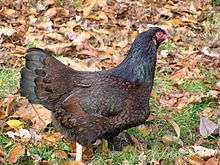Cornish chicken

The Cornish or Indian Game is a breed of chicken from the county of Cornwall in England. Cornish chickens, as well as crosses of Cornishes, are the most-used breed in the chicken meat industry.[1] They are heavy, muscular birds that lay brown eggs.
Name
The Cornish is known variously by Indian or Cornish Game depending on country. In America it was originally always known as Indian Game, until 1905 when the American Poultry Association passed a motion to rename the breed to Cornish Indian Game. Due to the confusion the name caused by implying the breed came from India, and unpopularity of the use of Game in the name, it was renamed to simply the Cornish in 1910.[2]
In Australia they are still known solely as Indian Game.[3] Usage of the two varies in the United Kingdom, but it is officially the Indian game according to the Poultry Club of Great Britain.[4]
History
The breed was developed by Sir Walter Gilbert, 1st Baronet around 1820. It was accepted by the American Poultry Association in 1893.[2]
Description
It is a large, stocky breed, and is often crossed with other breeds to enhance meat production. There are two variates, the Cornish Game and the Jubilee Cornish Game. The Cornish Game is dark blue - green in color, with brown patterning on the hens. Jubilee Cornish Game are much lighter, and less stocky than their counterparts. They are usually light wheaten in color, with light brown patterning.The Indian game, also known as Cornish, is sometimes called the bulldog among chickens; you can actually see the roast chicken shape in it. It was created because people wanted to cross the Asian game breeds with old English game to create a fantastic fighter. However, what they got (though not the right build for fighting) was a fantastic meat bird.
It comes in many colors and is quite a popular show bird, though it has a tendency for bad legs due to widely spaced hips. It is also when crossed with a Sussex or a Dorking, an excellent backyard meat bird. On average Indian Game produce 160-180 eggs per annum. Though aggressiveness is a common characteristic they are relatively easy to handle and make good mothers. Indian Game require more space than most other breeds so they may not be suitable for suburban producers or enthusiasts. The Indian Game is however highly prone to parasites, the Cornish must also be provided with extra shelter as their feathers tend to be thinner than other birds.
Weight
| Cock | 3.86 kg | 10 lbs |
| Hen | 2.57 kg | 5.7 lbs |
| Cockerel | >1 kg | >2.2 lbs |
| Pullet | >1 kg | >2.2 lbs |
| Rooster | 2.0 kg | 4.4 lbs |
| Hen | 1.5 kg | 3.3 lbs |
See also
Notes
- ↑ [Keeping Chickens Guide. Accessed Jan 21, 2010.
- 1 2 "Cornish Chicken". albc-usa.org. The American Livestock Breed Conservancy. Retrieved 1 August 2014.
- ↑ Australian Poultry Standards (2nd ed.). Poultry Stud Breeders and Exhibitors Victoria. p. 196.
- ↑ "Chickens: Hard Feather". poultryclub.org. Poultry Club of Great Britain. Retrieved 1 August 2014.
References
- Ekarius, Carol (2007). Storey's Illustrated Guide to Poultry Breeds. 210 MAS MoCA Way, North Adams MA 01247: Storey Publishing. ISBN 978-1-58017-667-5.
